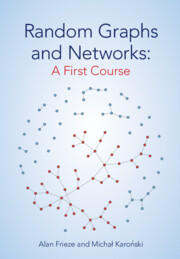
-
Select format
-
- Publisher:
- Cambridge University Press
- Publication date:
- 02 March 2023
- 09 March 2023
- ISBN:
- 9781009260268
- 9781009260282
- 9781009260305
- Dimensions:
- (244 x 170 mm)
- Weight & Pages:
- 0.61kg, 234 Pages
- Dimensions:
- (244 x 170 mm)
- Weight & Pages:
- 0.381kg, 234 Pages
You may already have access via personal or institutional login
Book description
Networks surround us, from social networks to protein–protein interaction networks within the cells of our bodies. The theory of random graphs provides a necessary framework for understanding their structure and development. This text provides an accessible introduction to this rapidly expanding subject. It covers all the basic features of random graphs – component structure, matchings and Hamilton cycles, connectivity and chromatic number – before discussing models of real-world networks, including intersection graphs, preferential attachment graphs and small-world models. Based on the authors' own teaching experience, it can be used as a textbook for a one-semester course on random graphs and networks at advanced undergraduate or graduate level. The text includes numerous exercises, with a particular focus on developing students' skills in asymptotic analysis. More challenging problems are accompanied by hints or suggestions for further reading.
Reviews
‘Random Graphs and Networks: A First Course’ is a wonderful textbook that covers a remarkable set of topics written by two leading experts in the field. The textbook is comprehensive and contains a wealth of theoretical preliminaries, exercises and problems, making it ideal for an introductory course or for self-study. It is the best starting point in the present textbook market for any university student interested in the foundations of network science.’
Charalampos E. Tsourakakis - Boston University
'This is a very concise, highly informative introduction to the theory of random graphs and networks ... Essential.'
M. Bona Source: Choice
Contents
Metrics
Altmetric attention score
Full text views
Full text views help Loading metrics...
Loading metrics...
* Views captured on Cambridge Core between #date#. This data will be updated every 24 hours.
Usage data cannot currently be displayed.
Accessibility standard: Unknown
Why this information is here
This section outlines the accessibility features of this content - including support for screen readers, full keyboard navigation and high-contrast display options. This may not be relevant for you.
Accessibility Information
Accessibility compliance for the PDF of this book is currently unknown and may be updated in the future.


